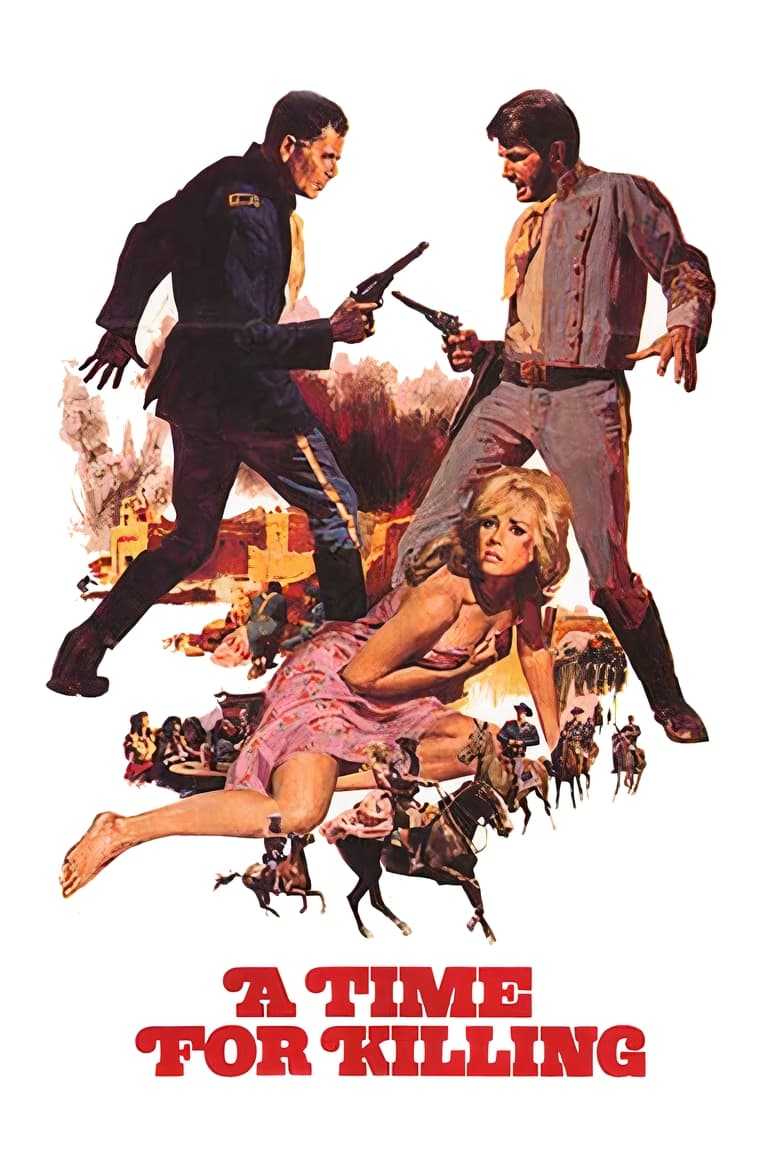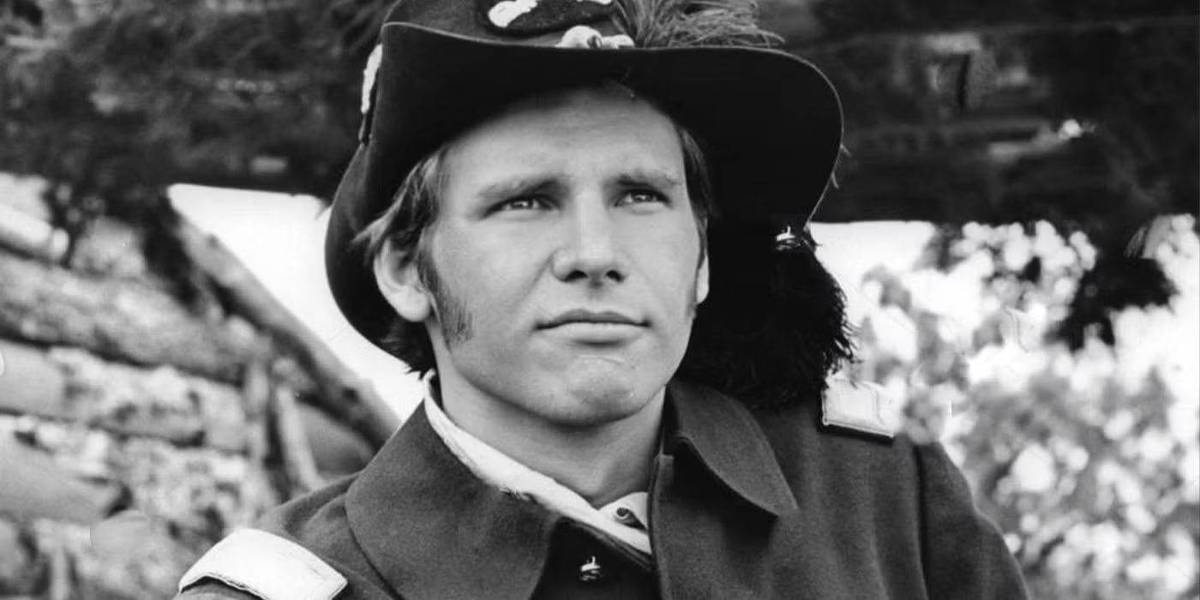A Time For Killing Ending Explained
A Time for Killing is a 1967 Western film that is more of a grim look at war and revenge than it is a rollicking shootout in the American frontier. Also known as The Long Ride Home, A Time For Killing is a Civil War Western set in a Union prisoner-of-war camp near the Mexican border where Major Tom Wolcott (Glenn Ford) is in charge of an inept group of Union guards and scheming Confederate prisoners. The prisoners are led by Captain Dorrit Bentley (George Hamilton), a Southern gentleman who is not as gallant as he would like to believe.
Along with being Harrison Ford's first credited movie role as Lt. Shaffer, A Time for Killing is best known for switching directors early in production. The film was first set to be directed by B-movie legend, Roger Corman, who left after reported fights with Columbia Studios, who grew frustrated with his thrifty filmmaking (via FilmInk). He was replaced with Phil Karlson, who directed the majority of the film. After the Confederate prisoners escape and flee to Mexico, they capture Wolcott's fiancé, Emily Biddle (Inger Stevens), beginning a race across the West for Wolcott as he attempts to save his love.
Captain Dorrit Bentley Assaults Emily
Bentley Goes Back On His Promise To Protect Emily
When the Confederate soldiers escape from the prison camp, they set their eyes on Mexico. Bentley hopes to continue fighting for the Southern cause from even further south even if the rest of the Confederacy gives up, which is beginning to look like a possibility in the waning years of the American Civil War. On their way down, the group, which also includes Harry Dean Stanton as Sgt. Dany Way and Max Baer Jr. as Sgt. Luther Liskell, just so happens to stumble across Emily, who is making her way home from visiting her fiancé.
The prisoners ambush and kill Emily's escort and take their horses and supplies. Posturing himself as a chivalrous Southern man, Bentley promises that no harm will come to Emily from either him or his fellow soldiers. Later, it becomes clear that Bentley has less control over his men than he implied because Emily goes to wash her face in a river and the sight of her unclothed neckline nearly sends the men into a frenzy over her. In the ruckus, Emily smacks Bentley on the thigh with his scabbard, humiliating him in front of the other men.
Later, the Confederates reach a small town and there, Bentley receives word that the war is over. Desperate to keep his "unit" intact, he hides the message. With his future grim, and his pride still hurting, Bentley takes it out on the only person he can: Emily. He drags her upstairs to a room and when she returns downstairs bloodied and with her clothes torn, it's obvious that the "chivalrous" Bentley is nothing more than a low, desperate criminal, beholden to his vices and ego as much as anyone. Fortunately, Major Wolcott arrives just at that moment.
Major Tom Wolcott Catches Up With The Escaped POWs
Wolcott Refuses To Chase Bentley Over The Border
Major Wolcott has been scouring the countryside looking for Emily. The expert tracker and his team, which includes Billy Cat (Timothy Carey), Sgt. Cleehan (Kenneth Tobey), Owelson (Kay E. Kuter), and Zollcoffer (Dick Miller), have found the prisoners' hideout and Wolcott knows right away what happened to his fiancé. Ford does his best-restrained acting in this moment, trying to hold in his rage as he hears the Confederates have ridden off. He and his Union soldiers set off in pursuit in a final run to the Mexican border.
Emily is an unusually self-possessed character in A Time for Killing.
Once he gets there, Bentley and the Confederates taunt the Union soldiers for being too late. Emily demands that Wolcott shoot Bentley. Emily is an unusually self-possessed character in A Time for Killing. While most damsel-in-distress characters of the era were beholden to the whims of the people around them, Emily is furious with her assault, and her outrage at having her vengeance stolen is frightening and moving. Wolcott apologizes and says he can't. The war is over and Bentley doesn't want more men to die, not for Emily's honor at least, he tells his incensed fiancé.
Major Wolcott Takes Revenge On Captain Bentley
Wolcott And Emily Part Ways
Bentley seals his own fate, however. Whether because he's ashamed of his actions or because he's been driven to despair by the Confederacy's defeat, he opens fire on Wolcott, giving him ample reason to cross into Mexico and kill the villain. The Confederate and Union soldiers have a shootout, resulting in a Union victory. Wolcott stands over the dead Bentley in a dark cellar before exiting it. Instead of stopping to embrace Emily, he walks right by her, abandoning his bride-to-be.
The Real Meaning Of A Time For Killing's Ending
Wolcott And Bentley Have Opposing Moral Codes
Throughout A Time for Killing, Major Wolcott tries his best to keep the peace between the Confederates and the Union soldiers. In the beginning of the movie, Wolcott stops a cruel form of execution on a Confederate prisoner sentenced to die and takes great pains to treat the men in his stead with respect and so that no harm comes to them. For his reward, his fiancé is raped, his men are shot at, and he is forced to exact violent retribution.
Wolcott and Bentley are played against one another; the man who speaks softly and carries a big stick, and the other, who is all bark and no bite.
Everything that Wolcott believes in ends up being for naught. Stoic and taciturn, Wolcott lets his actions speak for themselves, and it's this silent, grim, but honest nature that begins to create friction between him and Emily. It's Bentley who Emily feels more comfortable with and trusts to an extent. His honeyed words and notions of being fair and honorable hide an evil nature, but his facade is enough to get others to follow and trust him. Wolcott and Bentley are played against one another; the man who speaks softly and carries a big stick, and the other, who is all bark and no bite.
A Time for Killing is based on the 1961 novel, The Southern Blade, by Nelson Wolford.
While Wolcott ends up coming out on top in the end, killing Bentley, he also loses his fiancé in the process, who is outraged that he would choose the law over justice for someone he loves. A Time for Killing is a surprisingly brutal film, which is appropriate considering the brutality and misery of the Civil War. Wolcott's adherence to the law and his refusal to show his emotions does allow him to defeat evil, but it also robs him of some of his humanity. It's a deal that leaves the audience questioning if they would do the same.

A Time for Killing
- Release Date
- August 1, 1967
- Runtime
- 88 minutes
- Director
- Phil Karlson
- Writers
- Shirley Wolford, Nelson Wolford, Halsted Welles
- Producers
- Harry Joe Brown
Cast
 Glenn FordTom Wolcott
Glenn FordTom Wolcott George HamiltonDorrit Bentley
George HamiltonDorrit Bentley Inger StevensEmily Biddle
Inger StevensEmily Biddle Paul PetersenBlue Lake
Paul PetersenBlue Lake
A Time for Killing, set during the Civil War, follows Confederate soldiers escaping a Union prison, led by a captain aware of the war's end. Their journey to the Mexican border leads to a tragic clash with an uninformed Union search party, driving conflict amid the historical backdrop.
A Time for Killing
- Release Date
- August 1, 1967
- Runtime
- 88 minutes
- Director
- Phil Karlson
- Writers
- Shirley Wolford, Nelson Wolford, Halsted Welles
- Producers
- Harry Joe Brown
Cast
 Glenn FordTom Wolcott
Glenn FordTom Wolcott George HamiltonDorrit Bentley
George HamiltonDorrit Bentley Inger StevensEmily Biddle
Inger StevensEmily Biddle Paul PetersenBlue Lake
Paul PetersenBlue Lake
A Time for Killing, set during the Civil War, follows Confederate soldiers escaping a Union prison, led by a captain aware of the war's end. Their journey to the Mexican border leads to a tragic clash with an uninformed Union search party, driving conflict amid the historical backdrop.










Your comment has not been saved